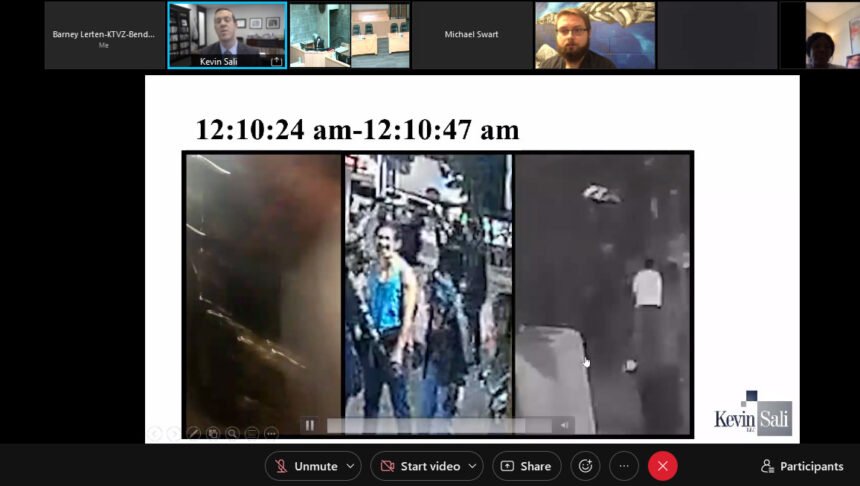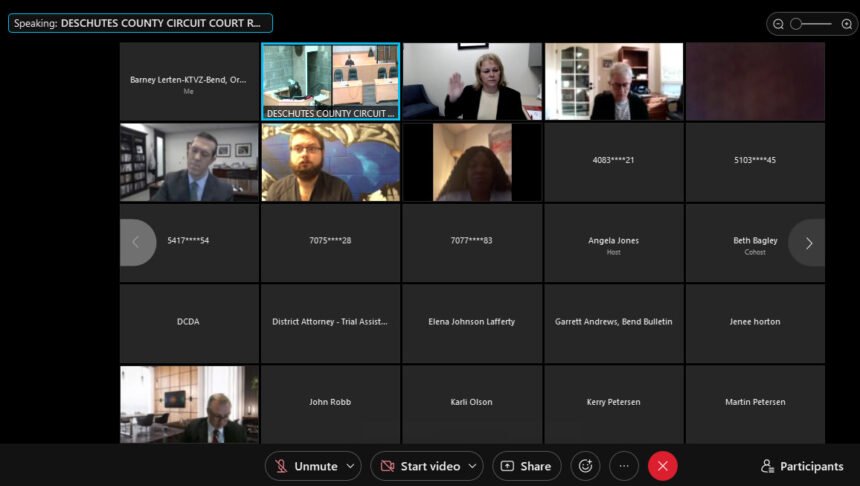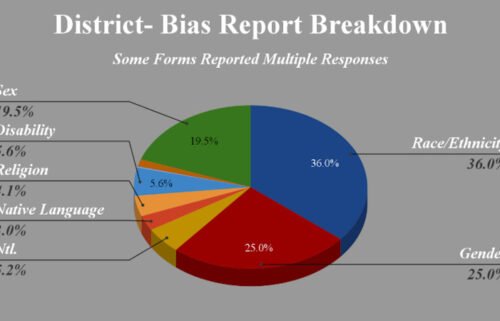Judge denies Ian Cranston release on bail; dramatic Barry Washington shooting video played in court


BEND, Ore. (KTVZ) – After dramatic videos of Ian Cranston’s fatal shooting of Barry Washington Jr. on a downtown street corner, and what led up to it, were played in court by a defense lawyer Monday afternoon, a Deschutes County judge rejected a defense attorney's request that Cranston be released on bail pending his November murder trial.
Circuit Judge Beth Bagley said, 'The evidence clearly establishes that the defendant, Mr. Cranston, shot Mr. Washington at close range, with a firearm,. and when he did so, he had the conscious objective to cause Mr. Washington’s death. And for that reason, the request for release is denied."
"And further, that under all the circumstances existing at the time Mr. Cranston used deadly force, causing the death of Mr. Washington, that use of deadly force against Mr. Washington was not reasonable, and not justified, and that the state has further disproved that the killing was justified as self-defense in the evidence presented in today’s hearing.
“For that reason, the court finds that the presumption of guilt and proof that the defendant committed the crime of murder in the second degree is strong and evident, and not justified as self-defense, and for that reason the request for release is denied,” the judge ruled.
Bagley also explained to the public that this was not a trial, and that such rulings are based on the lower burden of proof: “clear and convincing evidence,” not the higher burden of proof, “beyond a reasonable doubt,” as at trial.
Bagley's ruling came at the end of a day-long virtual hearing in the high-profile case, with Cranston observing from the county jail. Cranston, 27, has pleaded not guilty to second-degree murder, first- and second-degree manslaughter, first-degree assault and two counts of unlawful use of a weapon in the Sept. 19 shooting death of the 22-year-old Washington.
Defense lawyer Kevin Sali said in his motion for bail that the evidence, including witness statements and videos from downtown security cameras – as well as a cellphone video taken by Cranston’s fiancée –show prosecutors don’t have a strong case and that Cranston acted in self-defense after being hit in the face twice by Washington.
Deputy district Attorney J. Michael Swart claimed in his court filing in response that the video evidence showed Cranston waited 26 seconds “with his handgun at his side for the right opportunity to take his vengeance on Washington,” then 17 seconds to walk to and lean over Washington before eventually rendering aid.
In court Monday morning, Swart told the judge that a video taken from the Wild Rose Thai restaurant downtown “will demonstrate Mr. Cranston weighed the consequences, weighed the decision, for and against, and decided to take steps, raise his handgun, point it at the midsection of Mr. Washington, fire and kill Mr. Washington.”
“We believe that the facts show that he took a number of steps after being struck (and) was not facing deadly physical force at the time” he shot and killed Washington, Swart said.
Also in the hearing was attorney Erin Olson, representing Washington’s mother, Lawanda Roberson, who is seeking to review the evidence, including the medical examiner’s report and other material. She told the judge they had agreed not to publicize the materials provided, such as public comments or social media.
After the defense attorney objected to Swart’s motion last week to conduct the bail hearing by sealed affidavit – in essence, mostly closed to the public -- the attorneys apparently reached a general agreement on what documents would be discussed.
Bagley said she had not reviewed the Wild Rose video or other exhibits, but she did say that except for specifics covered in state law, an autopsy report from the medical examiner and grand jury transcripts, which will require a separate motion, “Other exhibits, interview transcripts, those are not going to be secret or confidential.” She said she planned to review the videos and other material during a midday break, before each side makes its closing arguments in the afternoon.
Bend Police Detective Camille Christensen was sworn in as the only virtual witness and was led by Swart through her role in the investigation and what she’d seen on the video: “Mr. Washington punched Mr. Cranston twice. Miss (Allison) Butler (Cranston’s fiancée) gets between Mr. Cranston and Mr. Washington. … Mr. Washington punches (Cranston’s friend, Tyler) Smith, and immediately after the punch, you see Mr. Cranston point his gun and shoot once, then put his hand down, and Mr. Washington collapses.”
The detective also said that no other weapon was found in the vicinity of Washington, other than the spent shell casing from the shot fired by Cranston.
Swart argued as the afternoon began that Cranston had “many other avenues he could taken” in the 26 seconds between the two blows to his head and when he raised his hand and shot Washington from “only a few feet” away.
The prosecutor said Cranston, who works around firearms and ammunition every day (had worked at Nosler) and is an avid hunter, “knew when he fired that handgun, he knew that it would cause a particular result, the death of Barry Washington.”
“This was a fistfight,” Swart said. “Mr. Cranston brought a gun to a fistfight. This was a fistfight that had subsided. Mr. Washington was not armed. There was no indication he was going to use any weapons. … no proof he was about to get the beating of his life.”
Sali then showed several videos, some in slow motion, and spotlighted in colors to identify the people in a fairly blurry security video. He frequently noted that Washington was 6-foot-2, 230 pounds, “muscular” and “extremely powerful,” and hit the “unsuspecting” Cranston with “two vicious blows to the head.”
The defense lawyer questioned how it can be argued Cranston had a “conscious objective” as the law states to kill Washington when he fired just once from a fully loaded handgun and within 20 seconds was rendering aid to him on the ground.
At one point, Bagley interrupted to ask about other parts of a submitted defense exhibit about self-defense and say: “Are you saying something prevents the court from reaching a reasonable conclusion that someone who has a weapon designed to kill, who shoots someone at close range in the center mass, torso, couldn’t draw reasonable inferences from that fact, it was that person’s conscious objective?”
Sali said, “If it was his actual will a few seconds earlier to end Mr. Washington’s life, why is he not only not doing anything further, but coming to his aid?” And he argued that state law says you are “entitled to use force if in fear of imminent death or serious physical injury … you don’t need to sit and wait to see how bad it’s going to be.”
Sali argued the video showed Washington had turned toward Cranston and raised his fists before the shot was fired, while the prosecutor said the imminent threat had subsided and he had backed away.
“What is an ‘imminent threat’ if that’s not it?” the defense lawyer said.
But the prosecutor said the defense’s argument was “rife with speculation.” He said the video showed “no indication whatsoever that Mr. Washington was coming at Mr. Cranston.” He said Cranston stepped toward Washington and “fires point blank,” using “totally disproportionate force.”
Roberson, Washington’s mother, got a chance before the judge’s decision to give her own, tearful statement on camera about her son, who she remembered as a “smiling, friendly big teddy bear.”
“When he left, he said, ‘Momma, I’m gonna be good,’” she recalled, also disputing any claim her son was flashing gang signs: “My son was not armed. My son was not in a gang.”
Roberson said her son should not have hit Cranston, but added, “I know my son. He would have not hit someone unless he was provoked.”
While DA John Hummel did not find enough evidence of a bias crime, Roberson told the judge, “I strongly believe in my heart BJ would not be dead, if he were not Black,” noting the hateful online comments posted on a video taken Cranston’s girlfriend, some saying he deserved to die.
“BJ chose Bend as a place to learn a new trade, in a new state. He did not choose it to be a place to die. That choice was made by Ian Cranston,” Roberson said, in tears.





